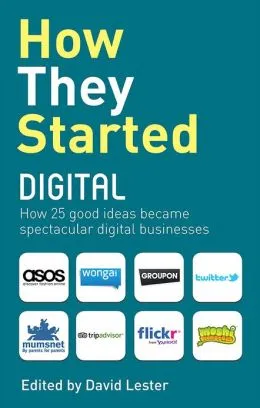How They Started Digital: How 25 good ideas became spectacular digital businesses

'How They Started Digital' provides a good overview of the birth, evolution and pivoting strategies of 25 digital businesses, categorised into six clusters: entertainment, social media, leisure/content, retail, finance and technology.David Lester is an entrepreneur, writer and investor; in addition to the usual suspects (Google, Pixar, eBay), he covers some European startups as well.
“These are great times to start a business,” begins Lester. “Will Moscow, Shanghai, London or some other hubs be able to produce a world-leading digital business on a scale similar to Twitter, Dropbox, or Google?” he challenges the readers.
Each case profile is about ten pages in length and makes for an informative read; I have summarised some highlights, takeaways, unusual facts and 'lightbulb moments' below.
European music startup Spotify was launched in 2008 and hopes to succeed in the US as well. Founder David Ek began with the digital ad business in Sweden, and teamed up with Martin Loventzon, who worked on search engine optimisation. They actually regarded the music pirate sites as pioneers and innovators (!), and then launched a legal version of their online music service, Spotify (spot + identify). Launched in six European countries, they received funding from Northzone, Creandum, and Hong Kong’s Li Ka-Shing.
Electronic Arts founder Trip Hawkins early on realised in the 1970s that computers would become commonplace, and found a terrific mentor in Steve Jobs, from whom he learnt how to be ‘creative and unstoppable.’ Hawkins treats his game developers not as serfs but almost like independent artistes in a music label. Investors included Capital Management (which became Sequoia Capital).
Hawkins effectively hired an experienced high-ranking PR expert (for ‘adult supervision’), played VCs off against each other to get a better valuation, and took big steps like reverse-engineering his games for big players such as Sega.
The early insight that Match.com founder Gary Kremen had was that as there were fewer women online than men in the early days of the Net, he could make money by ‘controlling the few women and charging a lot of money to the men!’ Print classifieds were slow to move online, leaving the field open for Kremen. His creative slogan was: ‘Match.com will bring more love to the planet than anything since Jesus Christ!’ The site’s competitor now includes sites like PlentyOfFish.com.
Social gaming company Zynga was valued at $3 billion within two years of founding. Co-founder Mark Pincus had earlier co-founded social media platform Tribe Networks; the name Zynga came from his bulldog Zinga. He picked up tips from Korean social network sites, such as selling virtual gifts that users could give to friends. He embedded social features into games, such as a bar which showed users what other games their friends played.
Pincus created an informal culture at the workplace, with pets, massages and chefs. He also ensured that investors did not have too much control of the company. His first foreign office was in Bangalore.
Animation powerhouse Pixar (‘pixel maker’) realised that storytellers were as important as animation PhDs, and moved from ads to full-length movies. Steve Jobs took the company to a legendary IPO, which helped negotiate a merchandising deal with Disney films.
Twitter co-founder Evan Williams was earlier behind the startup Pyra Labs which launched the Blogger tool. The next startup, Odeo, focused on podcasting, but it was actually one of their workflow tools for status sharing that became what is now called Twitter. The South by Southwest (SXSW) festival in Austin was the tipping point for hooking people into sharing realtime updates on events.
The choice of open source platform spawned tools such as Tweetdeck, which was acquired by Twitter itself for $40 million. Tweets during Obama’s election campaign and the Arab Spring helped cement Twitter’s position as ‘140 characters that changed the world.’ The business model of promoted tweets only came later in the story.
LinkedIn founder Reid Hoffman began working at Apple, Fujitsu and Paypal, and first created Socialnet, an early social networking site. The harsh business climate of the economic downturn made him realise the importance of business networking, and he launched LinkedIn; competitors like Tribe and Friendster soon followed.
DropBox co-founder Drew Houston got the company’s file-hosting idea when he once was on a bus and realised he did not have his memory stick with games on it. The startup’s investor insisted he get a partner, and he showed it to a fellow student at MIT who immediately dropped out to join the company.
The next investment was led by Sequoia’s Sameer Gandhi, and the founders joked that they initially did not know how to get the million dollar investment into their account! The plucky startup even turned down an acquisition offer from Steve Jobs.
Google co-founders Larry Page and Sergey Brin started their Web indexing project at Stanford University, and their downloading of Internet content cost the department $20,000 for every full download of the Net in those days. Their university background led them to extend the academic reference model to page links as well.
They offered the technology on sale to Excite, Yahoo and Altavista, who amazingly turned down the offer. The co-founders later evolved their pay-per-click model, and then a slew of offerings such as Google Images, Google News and Gmail. Page and Brin were actually reluctant to go public and reveal their financial models, but later did so. The company is renowned for its legendary creative culture today.
TripAdvisor founder Stephen Kaufer is a major player in ‘citizen tourism,’ to tap realtime aggregated tourist feedback instead of generic tourism brochures. A big break came when Expedia signed on for an ad trial. Lessons learnt included dealing with spam and spurious reviews which damaged hotels. TripAdvisor later acquired SmarterTravel, BookingBuddy, SeatGuru, TravelPod, UK’s VirtualTourist and China’s Kuxun.cn.
Canadian startup Flickr’s founders were members of online communities such as Salon.com, and tapped into the insight that photography can be a social experience -- through sharing, commenting and updating. The domain name Flicker.com was already taken, so they dropped the ‘e’!
Wikipedia founder Jimmy Wales was influenced by his childhood love for encyclopedia sets like Britannica. He tapped into the open software movement of the 1990s to come up with a model called Nupedia – but it was too academic and rigidly structured and hence failed to be sustainable. He closed Nupedia and reopened as Wikipedia with a crowdsourced model instead and a non-profit foundation as structure.
eBay founder Pierre Omidyar worked at mobile communications startup General Magic and then started AuctionWeb, which eventually became eBay (‘echo bay’). He survived the dotcom bust which wiped out Boo.com, eToys and Webvan.
Oli Christie, founder of gaming company Neon Play, had a good knack of developing games in tune with broader social trends – such as adding a punching feature when a Labour MP in the UK punched a protestor, or advergaming for big corporates, or Flick Football when the iPhone app store was launched.
UK fashion e-commerce site Net-a-Porter founder Natalie Massenet began as a journalist. “As a journalist, you see amazing ideas come along,” she says, and she decided to execute one such idea rather than just write about it. Her network helped build business contacts and also generate PR.
Travel site CheapFlights was also founded by a travel journalist, John Hatt. He then created a new site for hotel deals called CheapNights.com – but it had potential connotations of sleaze, so he re-branded it as CheapAccommodation.com!
Other profile startups are Groupon (‘group coupon,’ now in over 45 countries), Etsy (e-commerce site for handicrafts), Mind Candy (Moshimonster games for kids), MumsNet (founded by two journalists who were also mothers), Made.com (furniture e-tailer), Asos (UK fashion e-commerce site), Wonga (short-term consumer finance), GoCompare and MoneySupermarket (comparison sites).
In sum, key takeaways for startups from these case profiles are:
1. Tap your childhood insights, passions and even painpoints - they will sustain you in the long-run.
2. Even if you currently have a fulltime job, there are insights all around you which can become a full-fledged startup.
3. Even economic downturns are good times to conceive of and launch startups.
4. The ‘aha’ moment or ‘lightbulb’ moment can happen anytime and anywhere – keep your senses and intuition open!
5. Watch for ‘adjacent’ innovation models – an idea in one sector can also be applied in another.
6. Keep an eye on ‘fringe’ innovators who may have great ideas but controversial business models, eg. piracy sites!
7. The name for your company or product is around you somewhere, draw on yourself for inspiration.
8. Come up with catchy slogans and mottos which will make people sit up.
9. Internal and external storytelling are important tools to harness and skills to develop.
10. Look for good ‘launchpads’ for your products, eg. startup conferences and awards competitions.
11. Build a good team and treat them like stars; create a culture of learning and quality.
12. Find a good mentor who embodies what you aspire to be.
13. Get funding to scale, but don’t let investors run your company.
14. Make sure the product is workable and solves an important problem, then embed payment streams.
15. Choose your partners well, and tweak your product to fit into the ecosystem of big players.
16. Tap into current and emerging business and social trends, eg. embed social, mobile and crowds into your growth plans.
17. Be ready to pivot to a new audience, new product, new feature or even new company name.
18. Watch out for hidden sources of risk which can torpedo your venture; be prepared with legal defences and PR strategies.
19. In the long run, roll out not just products but platforms and ecosystems.
20. Go global: learn from successful startups and innovators around the world. Set up centres in other parts of the world for market expansion, support and localisation. Acquire foreign companies to scale where necessary.
[Follow YourStory's research director Madanmohan Rao on Twitter].







